The Best Deals on Camping, Backpacking and Outdoor Gear [June 2025]
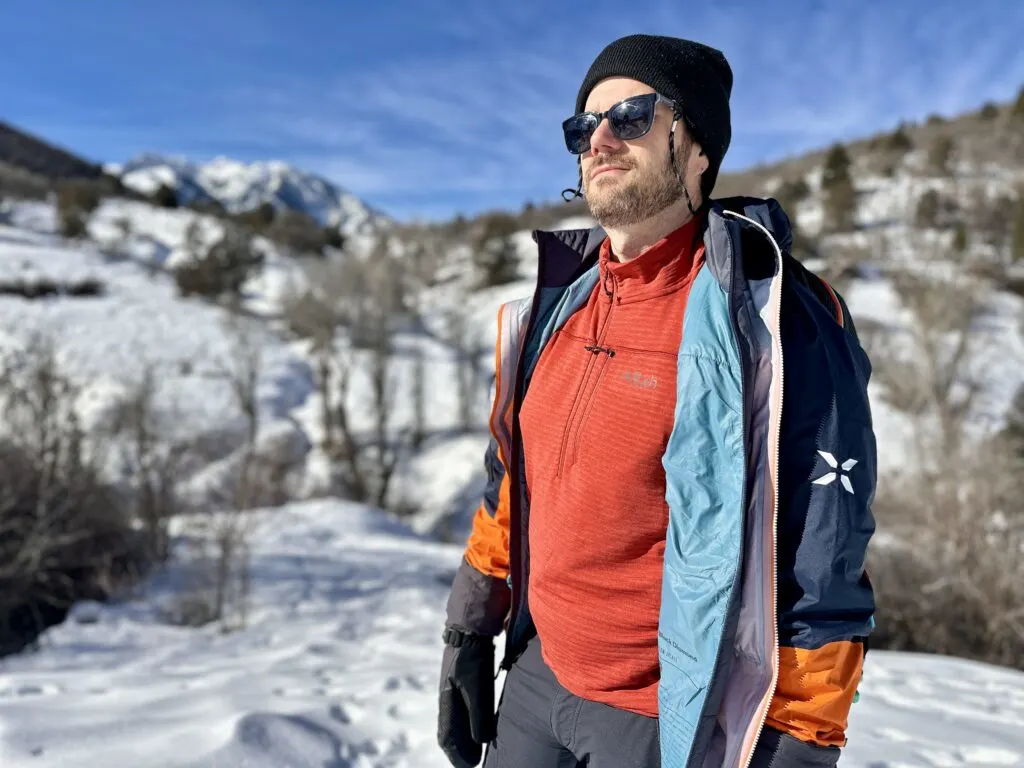
We’re big fans of snowshoeing. We love hitting quiet, powdery trails no one else is on, layering up, and hiking to enjoy a snack and a hot beverage with a view (and we always bring a hot beverage). Do empty trails, wildlife sightings, and stunning scenery sound good to you, too? Then gear up! ‘Cause snowshoeing offers it all. But if you’re not sure what to wear snowshoeing or what gear you need, allow us to recommend some of our favorite clothing and gear for the task. Bonus: it’s all more sustainable than your average tech shirt. (Read more about what makes gear more sustainable in this article.)
Yup, we’ve tested plenty of winter gear and apparel and these are a few items that stood out. So whether you’re new to snowshoeing or looking to up your gear and apparel game, read on. (Not sure if snowy hikes are for you? Check out this post full of tips for enjoying cold weather adventures.)
Pro Tip
Never underestimate the importance of layering, which you can read about more in depth in this post, including why it’s so vital to staying warm and dry on the trail. But the bottom line is that more lightweight layers are better than fewer bulky layers.
What to Wear Snowshoeing:
- Baselayer: A fitted base layer like leggings and a synthetic long-sleeve shirt are an important foundation for staying warm outdoors.
- Midlayer: A secondary layer helps insulate you and keeps you warm, but should also be breathable.
- Insulating Layer: A puffy jacket or cozy sweater is necessary during snack breaks and long downhill hikes.
- Shell Jacket: A lightweight shell jacket keeps out the wind, rain, and snow.
- Water Resistant Pants: These keep your legs warm and dry.
- Gloves: A vitally important piece of gear.
- Waterproof Boots: These help keep your feet warm and dry.
- Snowshoes: Obviously.
- Backpack: Stash extra layers, snacks, even your snowshoes if you find you don’t need them.
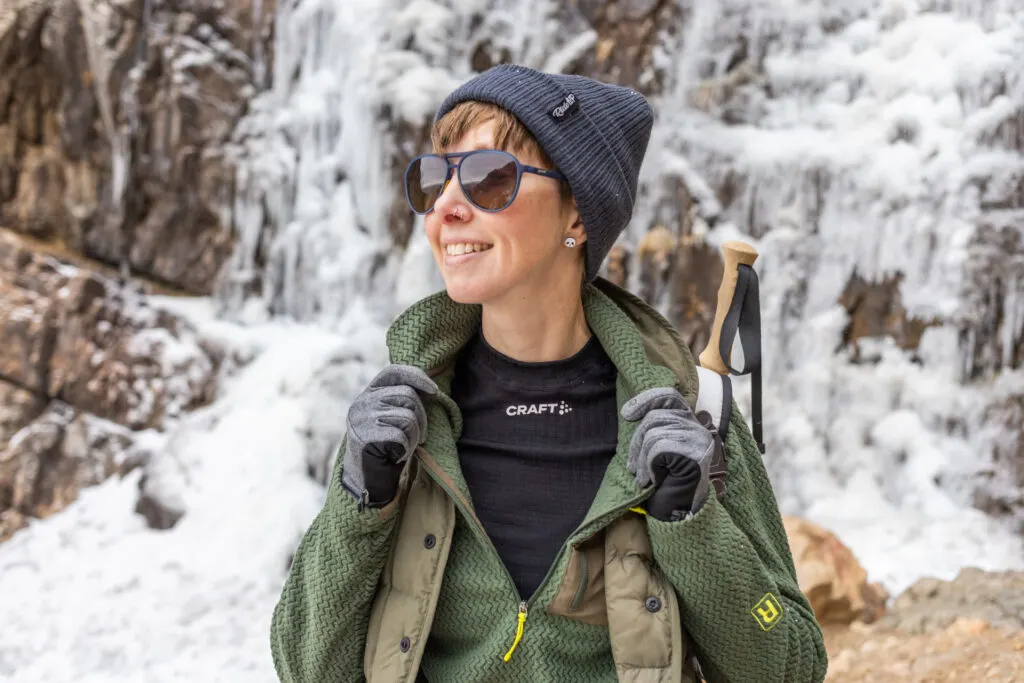
Best Baselayer for Snowshoeing: Craft Active Extreme X Baselayer
We’ve never been so obsessed with an active base layer as we are with the Craft Active Extreme X, which is absolutely best suited for days when you’re constantly on the move and working hard and sweating. It’s thin and light, but warm, stupendously stretchy, ultra comfortable and soft, and it wicks sweat like a boss. When snowshoeing in near freezing temps, our sweat dried in minutes after reaching the top of a long climb. It’s made of partially recycled materials, including SEAQUAL, which is crafted from ocean plastic.
Runner Up: A close second goes to the Mammut Aenergy FL Half Zip, which is stupendously light, excessively breathable and feels like wearing almost nothing. It’s also a Bluesign product, Fair Wear certified and made of recycled materials.
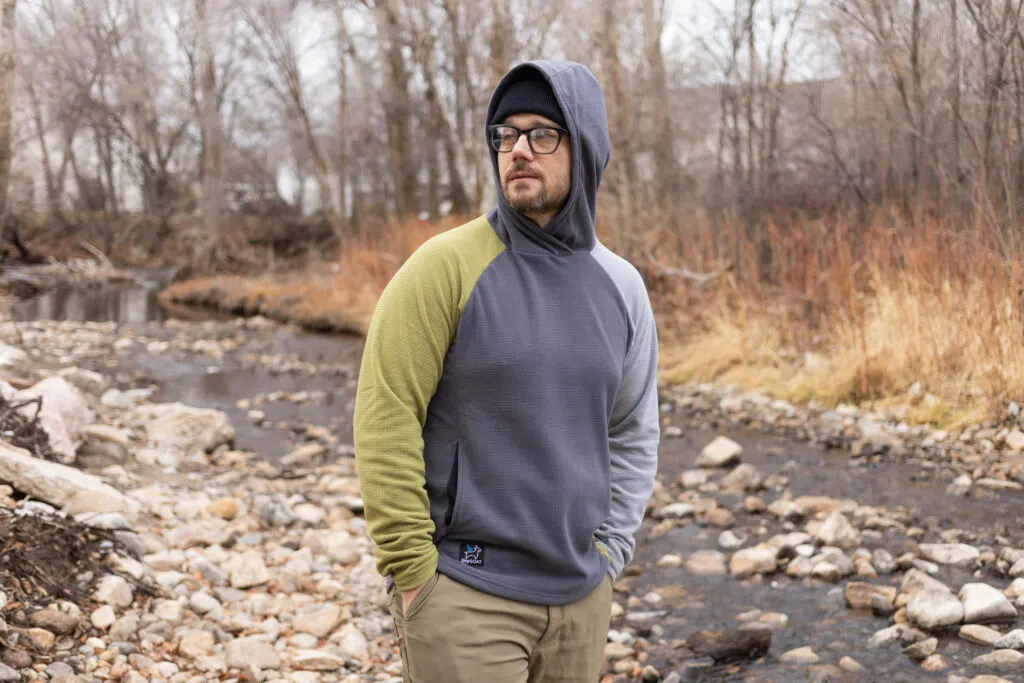
Best Midlayers for Snowshoeing: SkyGOAT Camp Hoodie
When you’re working up a sweat in the cold, you need a midlayer that insulates, but also breathes and helps wick sweat. For that, we love the SkyGOAT CAMP Hoodie. The interior is brushed so it’s super soft on our skin and the hood is fitted and cozy. But we especially love the kangaroo pockets, thumb holes and relaxed fit. The mismatched colorful sleeves are just a bonus. It’s made of proprietary recycled polyester by a small cottage brand based in Colorado.
Runner Up: The Rab Ascendor Light Pull-On is nearly as cozy, but without a hood, which we sometimes appreciate when wearing other hooded midlayers in order to reduce bulk.
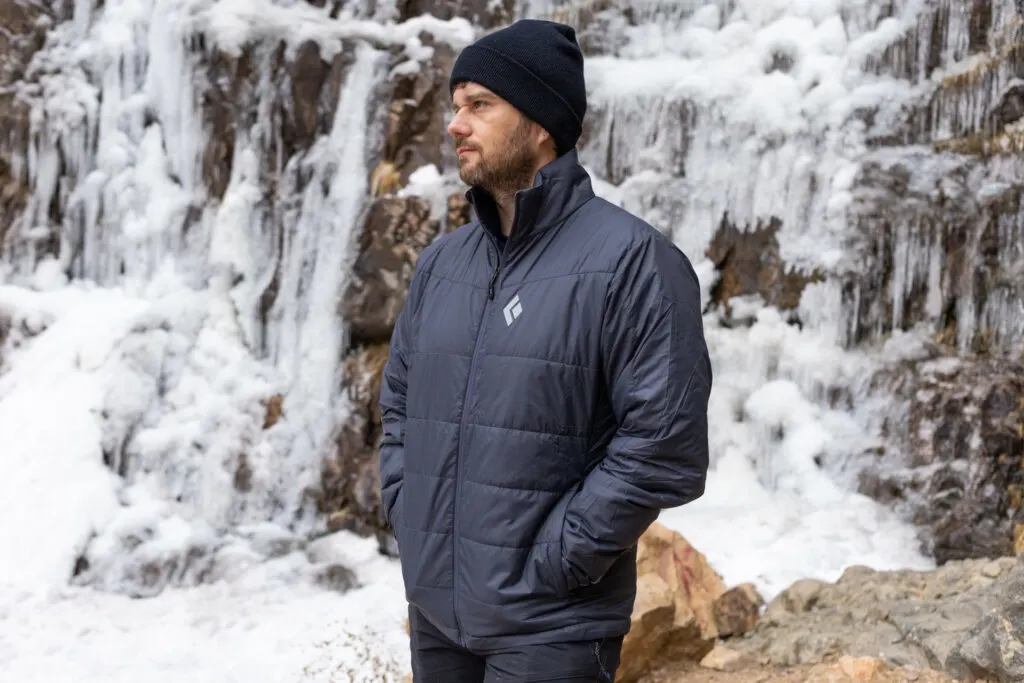
Best Insulating Layer for Snowshoeing: Black Diamond Solution Jacket
On truly cold days, a base layer and mid layer may not be enough; you need an insulating layer, too, especially for snack breaks or viewpoints. Because once you stop moving, you’ll cool down fast and you’ll need a layer that can both keep you cozy while on the move or during pit stops. Even long downhill hikes can feel a lot colder because you’re not working as hard.
For that, we appreciate the Black Diamond Solution Jacket, which is impressively light, packs down small when we warmed up and needed to stash it in a daypack, but also kept us cozy during breaks. It’s made of recycled material and is PFAS-free.
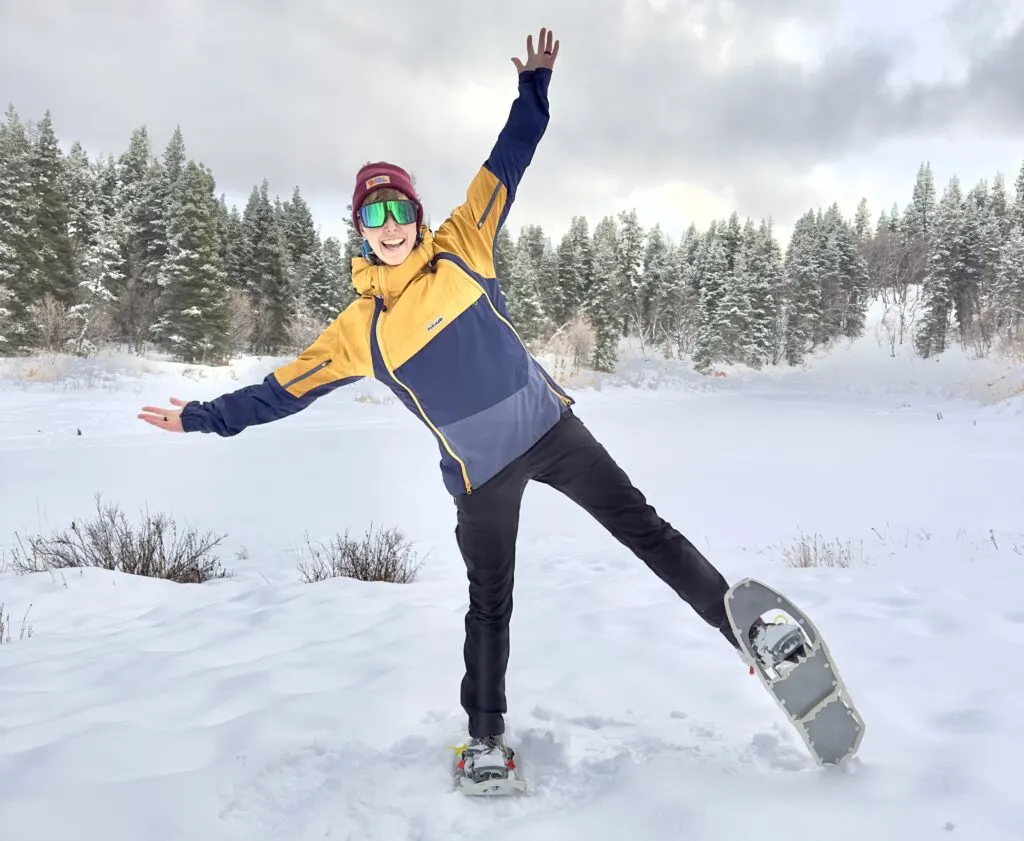
Best Jackets for Snowshoeing: Páramo Evolution Hybrid Smock
We love an anorak for all sorts of winter adventures. But they can be annoying to pull off and on. Páramo solved that problem (and plenty more) with the Evolution Hybrid Smock. It fully unzips on either side, which also offers excellent venting as you warm up, isn’t insulated but keep you warmer than a shell jacket thanks to an interior fabric liner, and has loads of large pockets, plus vents in the upper arms. The adjustable hood fits like a glove and because the jacket is made of a soft, breathable fabric, it’s practically silent, pliable, and easily repaired.
But it’s also designed to move sweat away from your body more efficiently than with a typical insulated jacket or shell. That means less sweat trapped inside to make you cold. And it’s still waterproof! But it is a bit on the heavy and bulky side. It is made of recycled materials, PFAS-free, and recyclable at the end of its life. Read our full review of the Páramo Jacket HERE.
Runner up: If you prefer to travel light, there’s no better ultralight option for staying protected in snow and wind than the Mammut Eiger Speed HS Hooded Jacket. It weights just 9.3 ounces, keeps you dry, and packs down to fit in the palm of your hand. Plus it’s made of recycled nylon, is PFAS-free, Bluesign approved, and Fair Wear Certified.
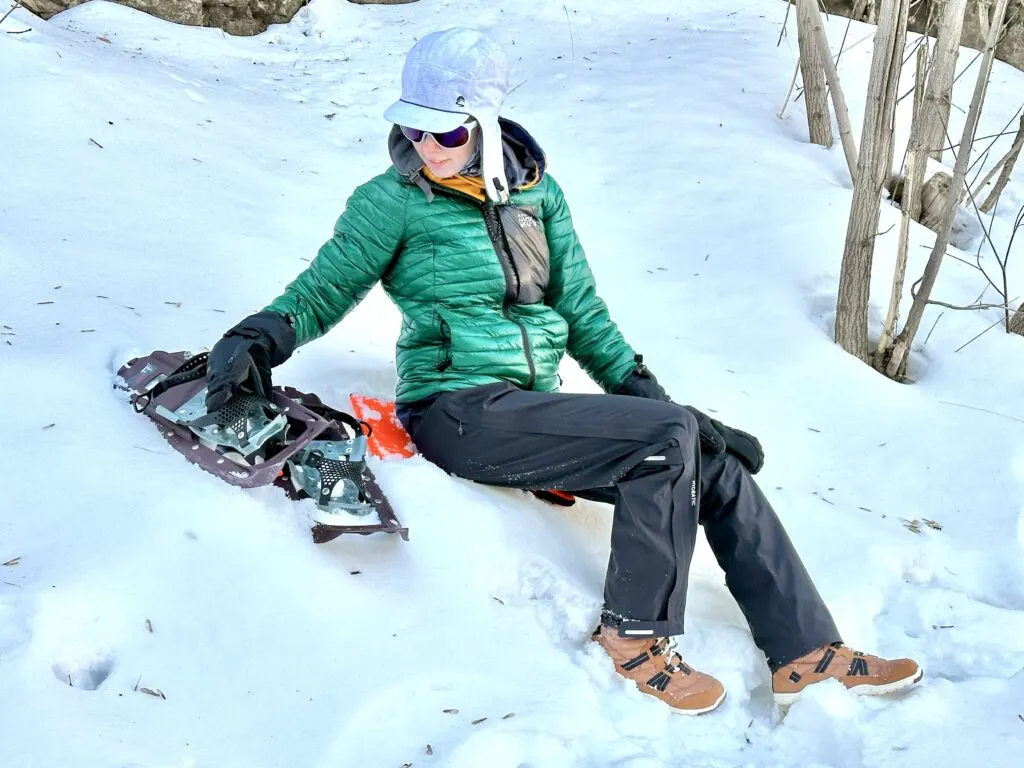
Best Pants for Snowshoeing: Fjällräven High Coast Hydratic Trail Trousers
Most water-resistant hiking pants are suitable for most snowshoeing adventures. But if it’s extra cold, a pair of insulated ski pants like the Backcountry Crestcruiser might be called for in order to keep your legs warm and dry. But a great option for longer snowshoe adventures or backpacking with snowshoes are a pair of lightweight waterproof shell pants layered over thinner pants, base layers, or leggings. We like the Fjällräven High Coast Hydratic Trail Trousers. They’re guaranteed to keep your bottom half dry, feature mechanical stretch, are PFAS-free, and are made with recycled polyester. Plus, they’re easy to pull on and off, even with boots on, and offer venting if you start to warm up.
Runner up: For those who squat to pee, there’s no better combo than the Gnara Go There pants and Go Free leggings with their patented pee zipper technology that makes layering and going to the bathroom in the cold stupid easy.
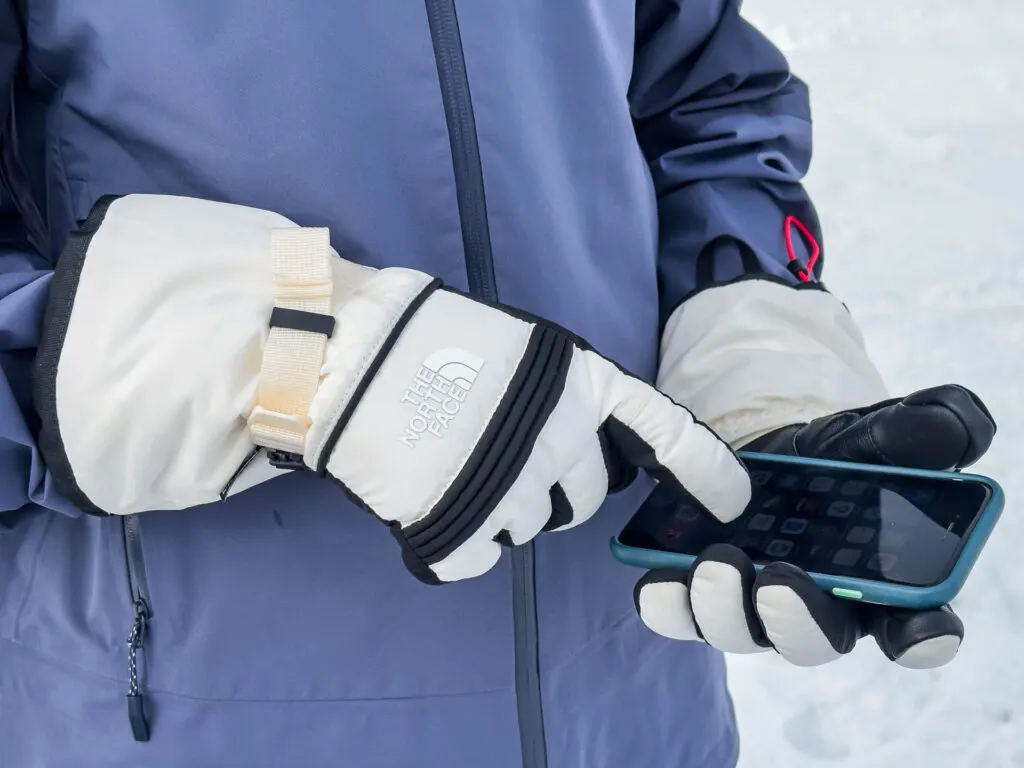
Best Gloves or Mittens: The North Face Montana Gloves
We’ve tested plenty of gloves and mittens, but some of our favorite sustainable gloves are The North Face Montana Ski Gloves for how warm and waterproof they are. A large gauntlet also makes them easy to wear over your jacket cuffs. Our favorite feature: they’re touch-screen compatible. Plus they’re PFAS-free and made of recycled materials. Don’t forget a pair of liner gloves to wear underneath, like The North Face E-Tip Recycled Glove.
Runner up: The Dakine Titan. They’re easy to take off and put on, have room for layering liner gloves, keep our fingers toasty, and even have a pocket for a key or hand warmers. They’re also made of partially recycled materials and PFAS-free (thanks to GORE-TEX’s new ePE membrane).
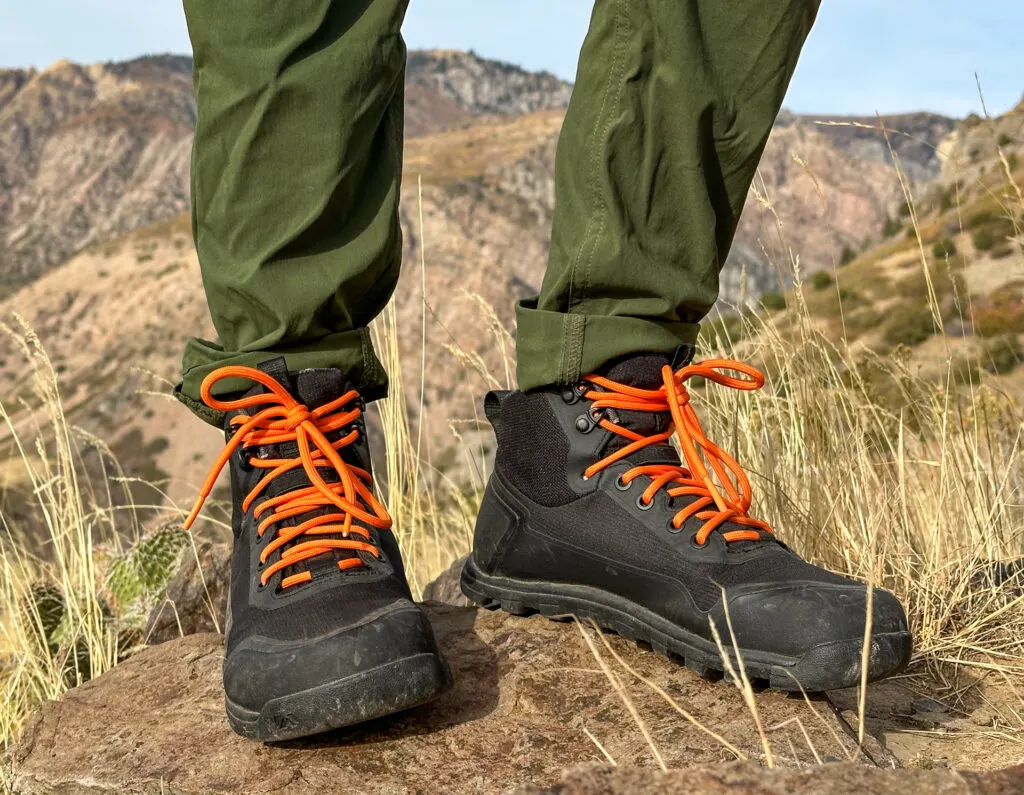
What Shoes to Wear Snowshoeing: Bahé Rediscover
As for shoes, you’re in luck: you can wear almost any shoes or boots with snowshoes, though some snowshoes don’t accommodate as wide a variety of boots as others. Some snowshoes you’ll have to order based on your shoe size, but even then they tend to fit a range of sizes. But most snowshoes will work with most shoes, though waterproof boots are the best choice. And sturdy uppers help ensure your toes won’t get smashed. For all that, we like the Bahé Rediscover boot, a minimalist, waterproof boot that also keeps you grounded and is PFAS-free, and partially made of bio-based and recycled materials.
Runner Up: For an even more barefoot option, we often snowshoe in any of These Minimalist waterproof hiking boots.
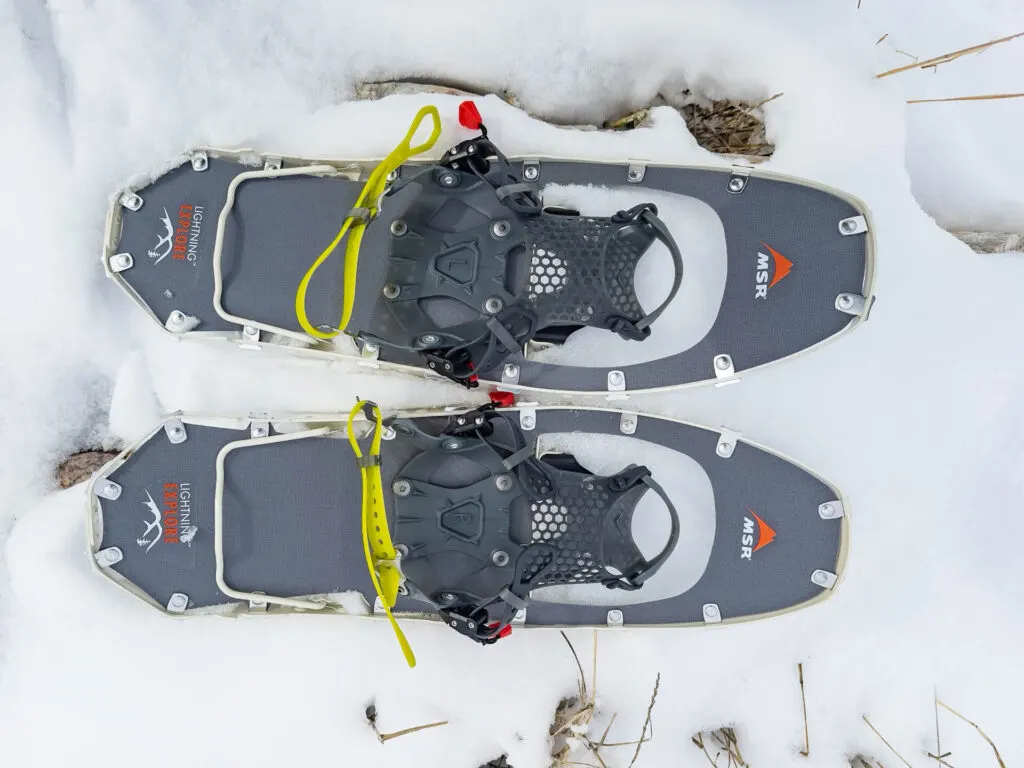
Best Snowshoes: MSR Lightning Explore
When it comes to snowshoes, there are plenty to choose from, and we’ve tested a few, but not all are created equal (as the extremely wide range of price points suggests). We recommend testing a few pairs out before you buy, not just to make sure you enjoy snowshoeing before you invest in a good pair of snowshoes, but to see what features you like best. Comfort will also come into play.
We don’t recommend opting for the cheapest pair unless that’s all you can afford, mostly because they’re likely to not last as long or be so noisy and uncomfortable that you don’t want ever want to take them out. We love our MSR Lightning Explore because they’re comfortable, highly adjustable, super dang quiet, and easy to walk in. Win-win-win. Want a nice pair but on a budget? Shop used on sites like Geartrade.
Runner up: The MSR Evo Trail snowshoes are still comfortable, durable, adjustable and more than capable, but at a lower price point.
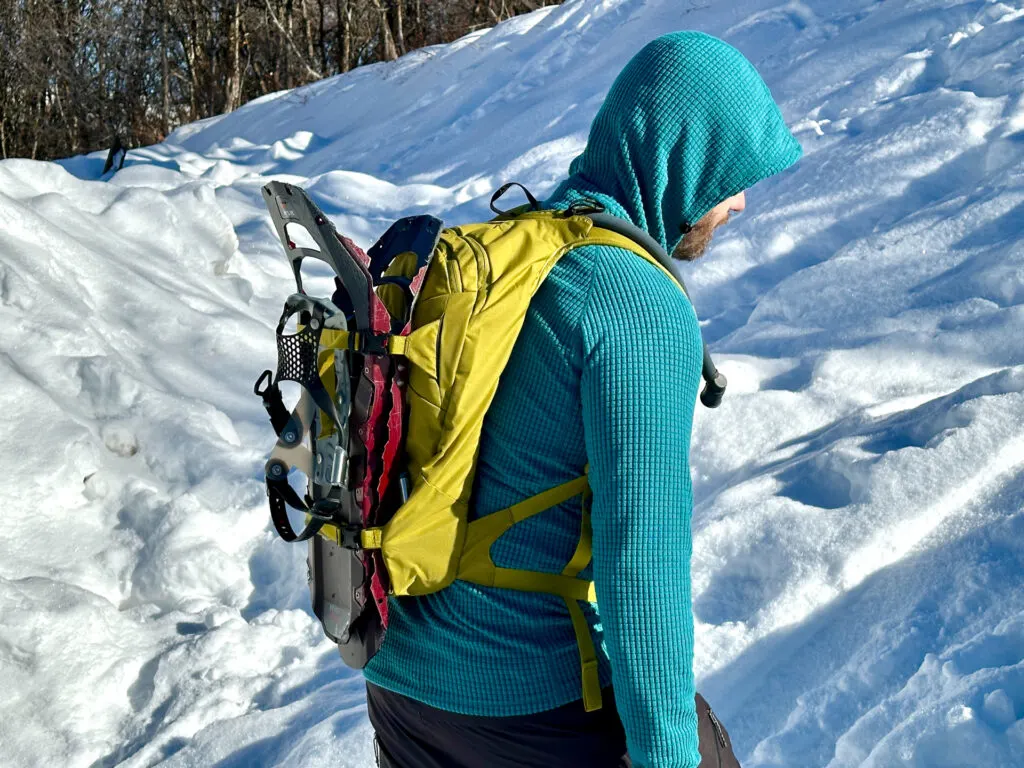
Best Backpack for Snowshoeing: Osprey Glade 12
While most any daypack can be used for snowshoeing, some are especially well-suited to hiking with extra bulky gear in the cold, including the Osprey Glade 12 pack. It comes with a hydration reservoir outfitted with an insulated tube to keep water from freezing on its way to your mouth plus two stowable straps on the front of the pack body that can be used to secure a snowboard, skis or snowshoes. That’s helpful for hikes when you may not need snowshoes at the beginning of the trail, but may as you gain elevation and run into deeper snow.
It’s a bit small for all-day exploratory hikes when you need lots of snacks, extra layers, and hot beverages, but for most short snowshoe hikes, we love it. The only downside: there’s no water bottle pocket for additional warm beverages in insulated mugs, so you’ll have to stash those inside.
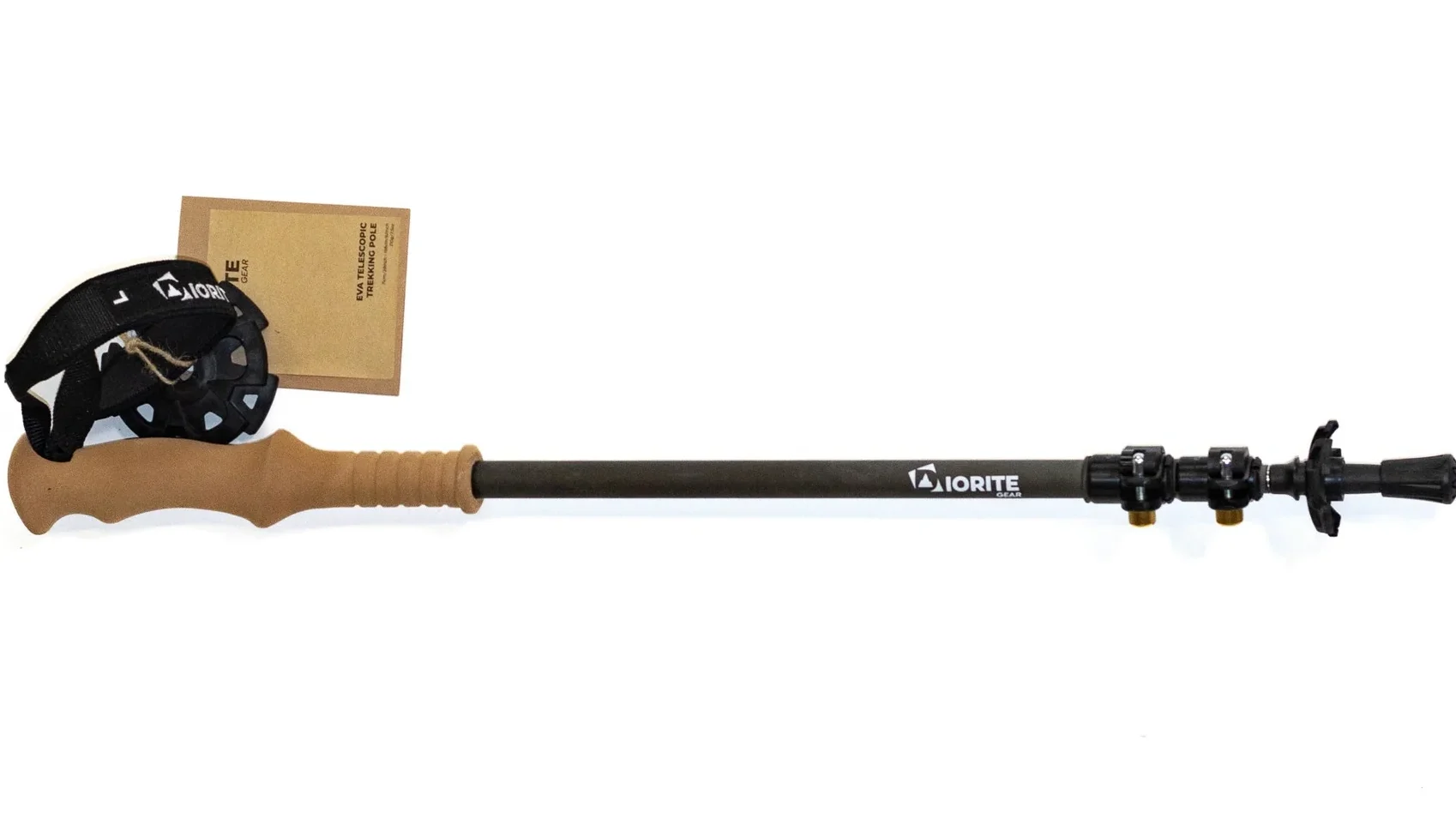
Best Trekking Poles for Snowshoeing: Diorite Gear Trekking Poles
Trekking poles are a must for snowshoeing, even if you don’t usually hike with trekking poles. That’s because it’s super easy to trip yourself up and end up face-first in a fluffy snow bank without them. That’s because snowshoes are big, bulky, flop around on your feet, and get caught in the snow easily, especially when you’re trying to back up, turn around, or step sideways. It’s easy to get edges stuck in the snow or step on your own snowshoe tail and then lose your balance. Trekking poles can help you stay upright.
We love our pair from Diorite because they’re repairable, easy to deploy, lightweight, and functional. Just make sure you get a pair with a snow basket or buy a separate accessory. That will help keep your poles from sinking a foot into the snow every time you plant them next to your feet.
Other Clothing for Snowshoeing
Don’t forget cozy socks, a neck gaiter, and some hand and toe warmers (we like the ones from Ignik). Come prepared for colder temps than you expect, just in case, and bring clothing to cover nearly every inch of exposed skin to help you stay warm.
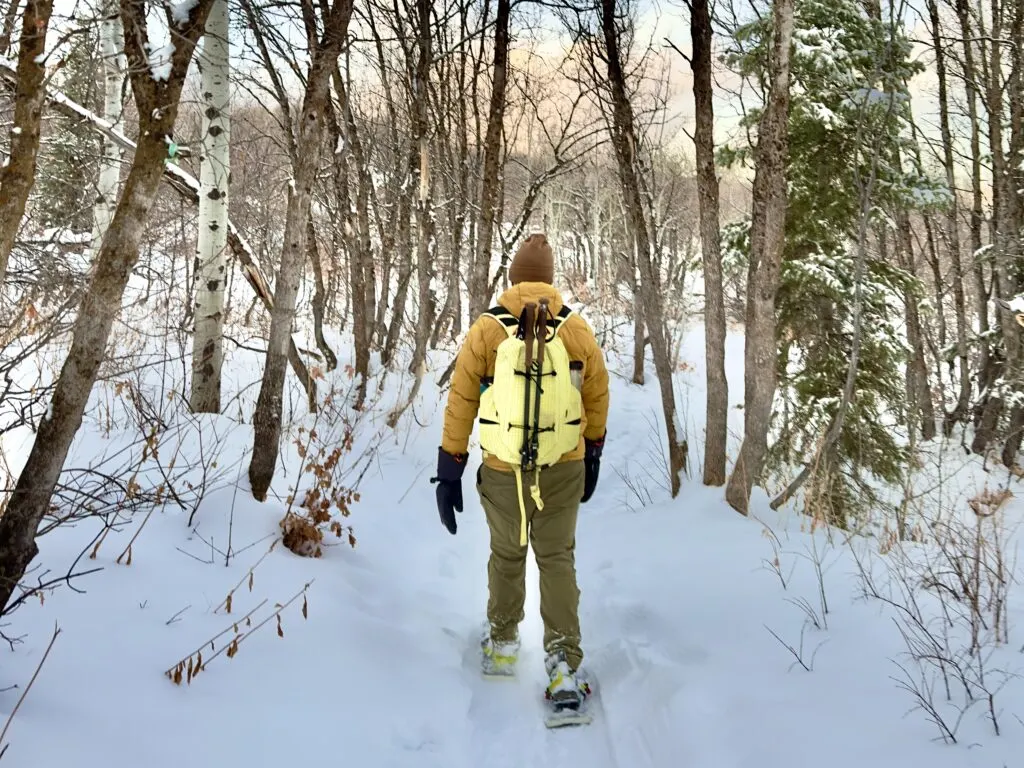
Bottom Line
Once you know what to wear snowshoeing, you can up your enjoyment on every hike. Just remember that layering is key, waterproof outer layers are important, and a hot mug of cider goes a long way toward boosting morale. Now get out into the snow and wander on already!
